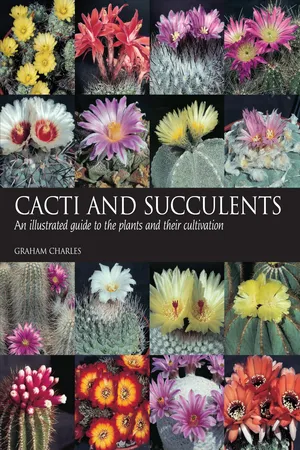
eBook - ePub
Cacti and Succulents
An illustrated guide to the plants and their cultivation
- 192 pages
- English
- ePUB (mobile friendly)
- Available on iOS & Android
eBook - ePub
About this book
Beautifully illustrated and highly accessible, this essential guide to cacti and other succulents is both a practical manual and a source of reference and inspiration for all enthusiasts. More than 250 different species or genera, and their natural habitats are described.Topics covered include the unique nature of succulents; the natural environment; history, classification and nomenclature; watering, feeding, general care and propagation; pests and diseases; profiles of cacti and other succulents. Beautifully illustrated with 420 colour transparencies.
Frequently asked questions
Yes, you can cancel anytime from the Subscription tab in your account settings on the Perlego website. Your subscription will stay active until the end of your current billing period. Learn how to cancel your subscription.
No, books cannot be downloaded as external files, such as PDFs, for use outside of Perlego. However, you can download books within the Perlego app for offline reading on mobile or tablet. Learn more here.
Perlego offers two plans: Essential and Complete
- Essential is ideal for learners and professionals who enjoy exploring a wide range of subjects. Access the Essential Library with 800,000+ trusted titles and best-sellers across business, personal growth, and the humanities. Includes unlimited reading time and Standard Read Aloud voice.
- Complete: Perfect for advanced learners and researchers needing full, unrestricted access. Unlock 1.4M+ books across hundreds of subjects, including academic and specialized titles. The Complete Plan also includes advanced features like Premium Read Aloud and Research Assistant.
We are an online textbook subscription service, where you can get access to an entire online library for less than the price of a single book per month. With over 1 million books across 1000+ topics, we’ve got you covered! Learn more here.
Look out for the read-aloud symbol on your next book to see if you can listen to it. The read-aloud tool reads text aloud for you, highlighting the text as it is being read. You can pause it, speed it up and slow it down. Learn more here.
Yes! You can use the Perlego app on both iOS or Android devices to read anytime, anywhere — even offline. Perfect for commutes or when you’re on the go.
Please note we cannot support devices running on iOS 13 and Android 7 or earlier. Learn more about using the app.
Please note we cannot support devices running on iOS 13 and Android 7 or earlier. Learn more about using the app.
Yes, you can access Cacti and Succulents by Graham Charles in PDF and/or ePUB format, as well as other popular books in Biological Sciences & Horticulture. We have over one million books available in our catalogue for you to explore.
Information
1 The Unique Nature of Succulents
Evolution and Adaptation
What are succulents and how do they differ from other plants? There is no absolute definition of a succulent, it is a case of degree – some plants are extremely succulent and others only slightly. Not everyone agrees and succulent collections often contain plants that are only marginally succulent. It is not just a case of storing water; to be a succulent a plant must have evolved ways to conserve its reserves. Some plants, such as begonias, have stems full of water but they are not succulent since they soon wilt and die in a prolonged drought. Succulence takes a number of forms depending on where the water is stored; for instance, there is leaf succulence where the leaves are enlarged with waterstoring tissues such as is seen in echeveria and mesembryanthemums. These leaves can exhibit modifications to reduce transpirational loss of water such as a covering of hair or a waxy bloom.
Stem succulents have thick stems where the water is stored and this is the strategy of most cacti and euphorbias. Stem succulents such as pachypodiums and some euphorbias have normal leaves that grow when water is available and shed in times of drought. Other succulents store water underground in swollen roots, an effective strategy in extremely arid places. In fact, the big swollen subterranean or surface storage may not be roots at all but an adapted part of the stem, for which the term caudex is often used. By combining different types of succulence a plant can be particularly effective at storing water during periods of prolonged aridity.

Lithops otzeniana, a leaf succulent that mimics the stones amongst which it lives.
Obvious examples of stem succulents are cacti, euphorbias and stapeliads, which usually have green stems because they have taken over the function of photosynthesis from the leaves, which are often absent or greatly reduced. In some cacti such as epiphyllums and schlumbergeras, the stem has become flattened and looks like a leaf. Where true leaves are present, they are shed at times of drought. The stems are usually ribbed or tuberculate to allow for expansion and contraction without damage as water is absorbed or lost. In cultivation, splitting can still occur due to excess water being given, particularly after a long dry period. Spherical or cylindrical stems are the best shapes to minimize surface area for a given volume.
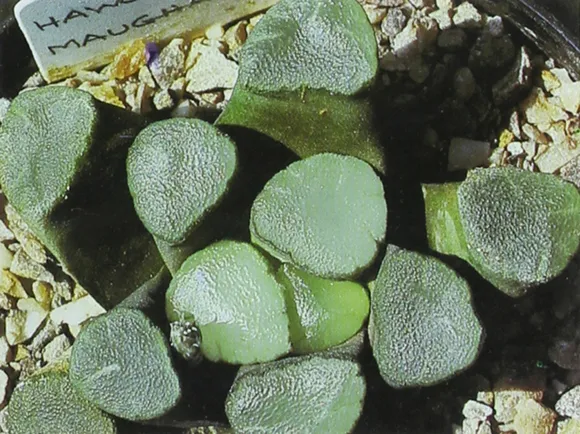
Some leaf succulents like this Haworthia maughanii have evolved windows in the tops of the leaves to allow photosynthesis within.
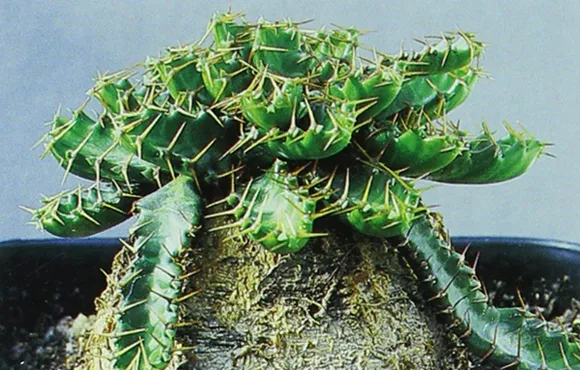
The caudex of this Euphorbia stellata would be underground in habitat. Photo: Tom Jenkins
A remarkable difference between most succulents and other plants is in the photosynthetic process they use to manufacture sugars. Normal plants have green leaves that contain chlorophyll and this is where photosynthesis takes place. Salts and water from the roots are combined by light energy from the sun with carbon dioxide from the air to make sugars. For this to happen, the carbon dioxide must be able to enter the leaf through pores in the surface called stomata that open during the day. Oxygen, which is produced as a by-product of the process, subsequently escapes through these open stomata. Evaporation of water also takes place through the open stomata, which is no problem to a normal plant since it can be replaced from the roots, but for a succulent this loss would reduce its ability to withstand drought. The solution adopted by most succulents is to open their stomata at night when the evaporation loss will be greatly reduced in the cool night air of their natural habitats. They achieve this by fixing the carbon dioxide taken in at night with organic acids that then break down into carbon dioxide and water during the hours of light to be available for photosynthesis. This adaptation was first observed in a member of the Crassulaceae family and is therefore known as Crassulacean Acid Metabolism (CAM). It is for this reason that greenhouse vents should be left open at night in summer to allow the temperature to drop enough for this process to work effectively, and why many cacti do not grow well when planted in tropical places where the night temperature regularly exceeds 20°C (68°F).
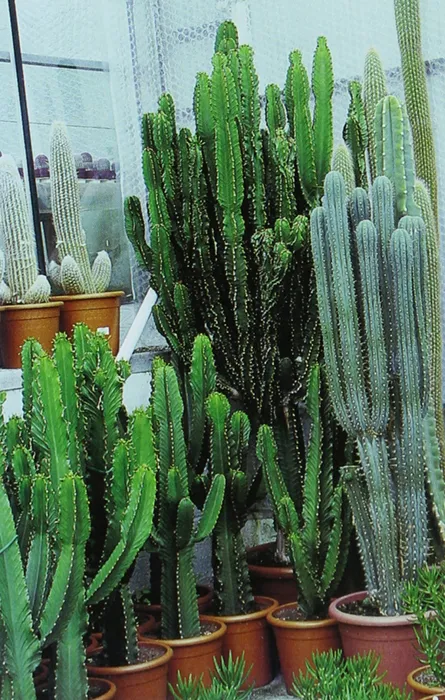
Stem succulents from Africa in the genus euphorbia (centre and left) look a lot like the New World cacti (right), but they do not have areoles, which are only found on cacti.
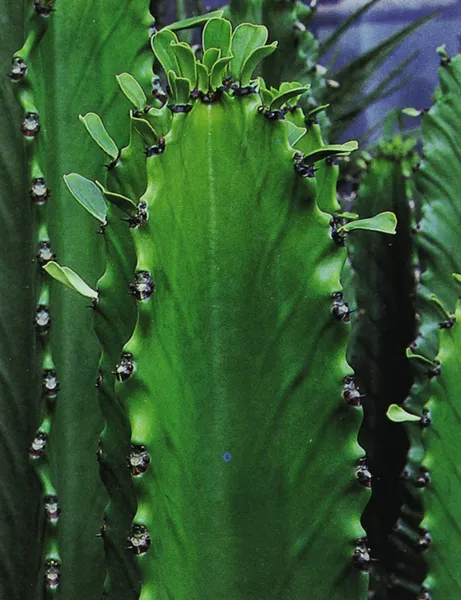
Many cactus-like euphorbias such as this E. ingens have leaves that are lost during the first dry spell.
The most common confusion is between true cacti and other succulents. What is the difference and how can you tell them apart? It is clear from the above that cacti are one example of succulent plants. The strategy of evolving succulence as a way of coping with long dry periods can be found in many plant families. In some, only a few genera or even a few species are succulent; while in others, all the genera are succulent. The cactus family (Cactaceae) is one of the latter; every cactus is a succulent. So how do you decide if a plant belongs to the cactus family? There is no simple way since plants from other plant families have evolved to cope with the same environmental conditions in the same way as cacti and hence look very like them. In fact, they look so alike that experts can sometimes be fooled so there is no need to be concerned if you have difficulty differentiating them. However, there are a few characteristics that, if taken together, can confirm that a plant belongs to the family Cactaceae. They all have spines, even though in some species they are greatly reduced and difficult to see; and they all have areoles, the structures from which the spines grow. These look rather like pincushions but can be very small and difficult to see in many species.
All cacti are from North and South America although they have been introduced to other continents where they have become naturalized so that they look like they belong there. The reason they are only found naturally in the New World is that they evolved after the landmass that became South America drifted away from Africa (part of Gondwanaland). Later, when South America moved northwards it came close enough to North America to allow cacti to migrate and evolve into the wealth of species found today in Mexico and the USA. Of course if you see plants in cultivation you will not know where they grow naturally so you depend on characteristics you can see. Cacti are most easily confused with the succulent euphorbias from Africa, which through parallel evolution have grown to look very like cacti. Look closely and you will see that euphorbias do not have areoles. Another obvious difference is in the flowers, which are small and usually insignificant in euphorbias but larger in cacti. With practice, the differences become more obvious but there are a few genera of cacti that look very different from the classic image. For instance, the primitive cactus genus pereskia has large leaves, thin stems and flowers that are quite reminiscent of roses, hardly what you would expect for a cactus, but they still have areoles. The various pictures in this book should provide the beginnings of an understanding of this dilemma and experience of cultivating plants will eventually make you wonder why you ever confused them.
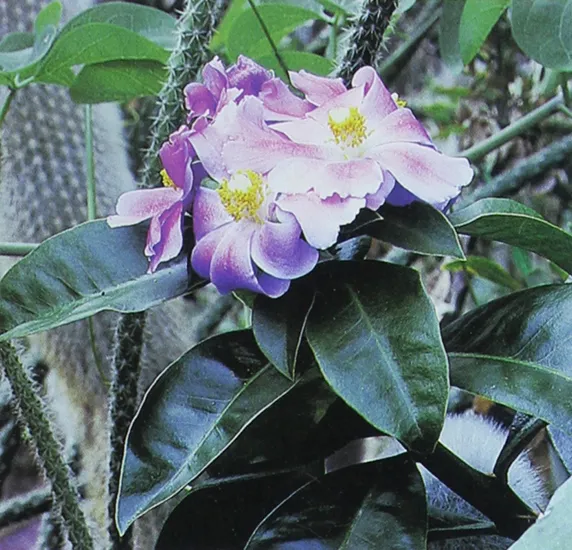
Pereskia grandifolia, a true cactus, has large leaves and flowers that look like a rose.

Some cacti like this opuntia have leaves that only appear on the new growth. Note the areoles.
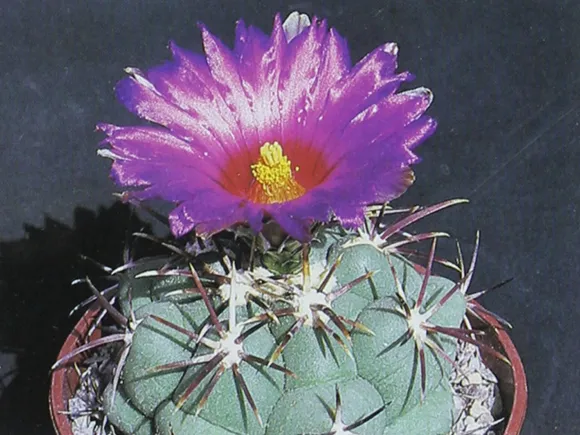
Cacti often have large bright flowers like this Thelocactus heterochromus, which also has prominent areoles from which the spines and flowers grow.
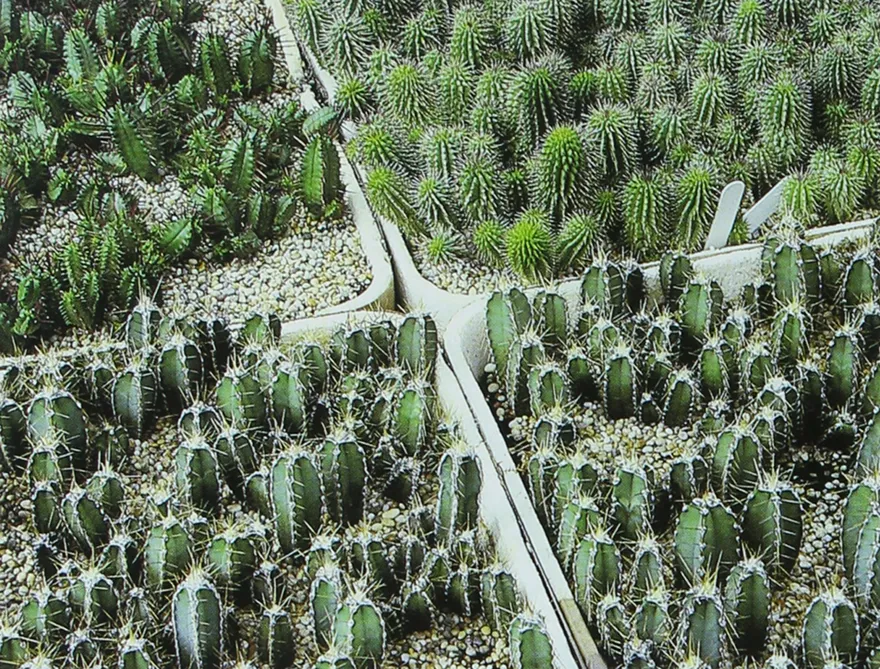
Seedlings of cacti (two trays in foreground) are very like those of other succulents – euphorbia (back left) and hoodia (back right).
Flowering
There is a commonly held perception that cacti do not flower, or that they do so only every seven years. The correct treatment of cacti is widely misunderstood, which might explain why well-grown plants are so rarely seen anywhere other than in specialist collections. All cacti and succulents are flowering plants – as long as their requirements are satisfied then they will flower, sometimes spectacularly, but always beautifully. Other than the correct cultural treatment, the only other criterion for flowering is maturity. Once a plant flowers for the first time it is mature and will flower every year thereafter, so long as the environmental conditions are right. Even in the natural habitat conditions may be unfavourable, for instance, a plant may miss a year with its flowering if there has been no rain. Not all individuals of the same species will flower at the same age; there are slight genetic differences that mean some will reach maturity before others. Rarely, a particular specimen may grow perfectly well, but for some reason will not flower, even though it is older and larger then others of the species that do so reliably. There are a few species that just will not flower in cultivation in northern Europe, either because of insufficient sunlight, or because they need to be extremely large before they are mature. However, they can still be valued for their architectural appearance.
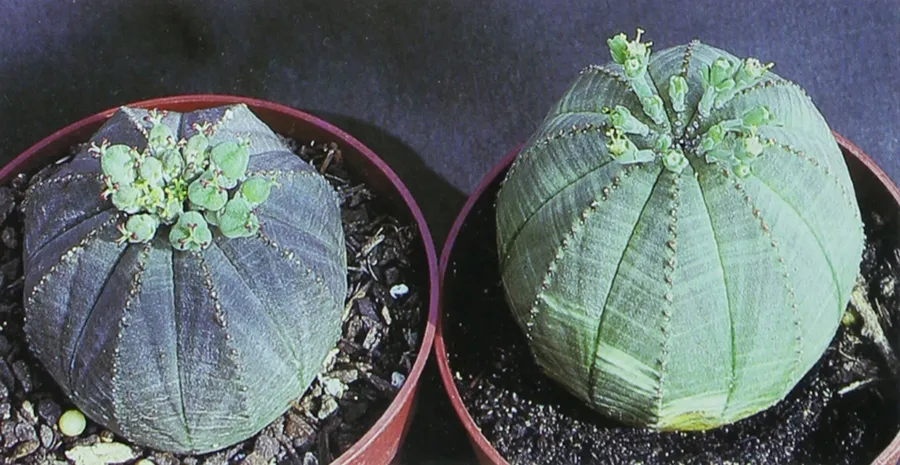
Euphorbias often have small and insignificant flowers. Some species such as E. obesa are dioecious: the female plant is on the left, the male on the right.
Flowers of most cacti are short-lived, sometimes just a few hours, depending on the weather and the species. They are produced from the areoles of the cactus and in species such as some rhipsalis and eriosyce, a single areole can produce a number of flowers, either simultaneously or in succession. The plants lose significantly more water when flowering than they do normally, and sometimes you can see the plant has shrivelled after its blooms have been open on a hot day. Some have evolved the ability to set seeds without actually opening their flowers, a phenomenon called cleistogamy. Frailea, for instance, are small plants that can ill-afford to lose moisture so they will only open their flowers when they are well watered and turgid, otherwise they rely on cleistogamy. This is less of a problem for the many night-flowering cacti whose flowers lose less water in the cool of the night. Healthy plants that are growing well flower the most but there is an interesting exception. If a specimen loses its roots and dehydrates it sometimes produces more flowers than normal, presumably in a last effort to reproduce. A similar effect can be obs...
Table of contents
- Cover
- Title
- Copyright
- Contents
- Preface
- 1. The Unique Nature of Succulents
- 2. Succulents in their Natural Habitats
- 3. Cultivation, Propagation and Display
- 4. Which Species to Choose – Cacti
- 5. Which Species to Choose – Succulents
- Appendix I: Where to Buy Plants, Seeds and Books
- Appendix II: International Societies and Special Interest Groups
- Appendix III: Further Reading and Reference
- Appendix IV: Glossary of Terms
- Index